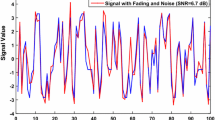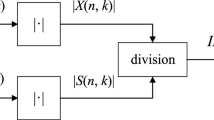Abstract
In this paper, the Correntropy Induced Metric (CIM) as an alternative to the well-known mean square error (MSE) is employed in Chebyshev functional link artificial neural network (CFLANN) to deal with the noisy training data set and enhance the generalization performance. The MSE performs well under Gaussian noise but it is sensitive to large outliers. The CIM as a local similarity measure, however, can improve significantly the anti-noise ability of CFLANN. The convergence of the proposed algorithm, namely the CFLANN based on CIM (CFLANNCIM), has been analyzed. Simulation results on nonlinear channel identification show that CFLANNCIM can perform much better than the traditional CFLANN and multiple-layer perceptron (MLP) neural networks trained under MSE criterion.











Similar content being viewed by others
References
Hassoun MH (1995) Fundamentals of artificial neural networks. MIT press, Cambridge
Hassoun MH (1996) Artificial neural networks for modelling and control of nonlinear systems [book reviews]. IEEE Trans Neural Netw 7(5):1316
Pao Y-H (1989) Adaptive pattern recognition and neural networks. Addison-Wesley, Reading
Hassoun MH, Clark DW (1988) An adaptive attentive learning algorithm for single-layer neural networks. In: IEEE international conference on neural networks, pp 431–440
Patra JC, Kot AC (2002) Nonlinear dynamic system identification using Chebyshev functional link artificial neural networks. IEEE Trans Syst Man Cybern Part B Cybern 32(4):505–511
Weng WD, Yang CS, Lin RC (2007) A channel equalizer using reduced decision feedback Chebyshev functional link artificial neural networks. Inf Sci 177(13):2642–2654
Mili F, Hamdi M (2012) A hybrid evolutionary functional link artificial neural network for data mining and classification. In: 2012 IEEE 6th international conference on sciences of electronics, technologies of information and telecommunications (SETIT), pp 917–924
Dehuri S, Roy R, Cho SB et al (2012) An improved swarm optimized functional link artificial neural network (ISO-FLANN) for classification. J Syst Softw 85(6):1333–1345
Patra JC, Pal RNA (1995) Functional link artificial neural network for adaptive channel equalization. Signal Process 43(2):181–195
Li M, Liu J, Jiang Y et al (2012) Complex-Chebyshev functional link neural network behavioral model for broadband wireless power amplifiers. IEEE Trans Microw Theory Tech 60(6):1979–1989
Mall S, Chakraverty S (2017) Single layer Chebyshev neural network model for solving elliptic partial differential equations. Neural Process Lett 45(3):825–840
Patra JC, Chin WC, Meher PK et al (2008) Legendre-FLANN-based nonlinear channel equalization in wireless communication system. In: IEEE international conference on systems, man and cybernetics, pp 1826–1831
Peterson LE, Larine KV (2008) Hermite/Laguerre neural networks for classification of artificial fingerprints from optical coherence tomography. In: IEEE seventh international conference on machine learning and applications, pp 637–643
Chakravarty S, Dash PKA (2012) PSO based integrated functional link net and interval type-2 fuzzy logic system for predicting stock market indices. Appl Soft Comput 12(2):931–941
Zhao H, Zeng X, Zhang J (2010) Adaptive reduced feedback FLNN filter for active control of nonlinear noise processes. Signal Process 90(3):834–847
Xu B, Wang Y, Yang X (2013) Navigation satellite clock error prediction based on functional network. Neural Process Lett 38(2):305–320
Lee TT, Jeng JT (1998) The Chebyshev-polynomials-based unified model neural networks for function approximation. IEEE Trans Syst Man Cybern Part B Cybern 28(6):925–935
Dehuri S, Cho SB (2010) A comprehensive survey on functional link neural networks and an adaptive PSO-BP learning for CFLNN. Neural Comput Appl 19(2):187–205
Zhao H, Zhang J (2008) Functional link neural network cascaded with Chebyshev orthogonal polynomial for nonlinear channel equalization. Signal Process 88(8):1946–1957
Purwar S, Kar IN, Jha AN (2007) On-line system identification of complex systems using Chebyshev neural networks. Appl Soft Comput 7(1):364–372
Zou AM, Kumar KD, Hou ZG (2010) Quaternion-based adaptive output feedback attitude control of spacecraft using Chebyshev neural networks. IEEE Trans Neural Netw 21(9):1457–1471
Golub GH, Van Loan CF (1983) Matrix computation. Johns Hopkins University Press, Baltimore
Liu W, Pokharel PP, Príncipe JC (2007) Correntropy: properties and applications in non-Gaussian signal processing. IEEE Trans Signal Process 55(11):5286–5298
Singh A, Principe JC (2009) Using correntropy as cost function in adaptive filters. In: Proceedings of international joint conference on neural networks, pp 2950–2955
Chen B, Xing L, Liang J et al (2014) Steady-state mean-square error analysis for adaptive filtering under the maximum correntropy criterion. IEEE Signal Process Lett 21(7):880–884
Zhao S, Chen B, Principe JC (2011) Kernel adaptive filtering with maximum correntropy criterion. In: Proceedings of international joint conference on neural networks, pp 2012–2017
Ma W, Qu H, Gui G, Xu L, Zhao J, Chen B (2015) Maximum correntropy criterion based sparse adaptive filtering algorithms for robust channel estimation under non-Gaussian environments. J Frankl Inst 352(7):2708–2727
Chen B, Xing L, Zhao H, Zheng N, Principe JC (2016) Generalized correntropy for robust adaptive filtering. IEEE Trans Signal Process 64(13):3376–3387
Yuan X, Hu BG (2009) Robust feature extraction via information theoretic learning. In: Proceedings of the 26th annual international conference on machine learning (ACM), pp 1193–1200
He R, Zheng WS, Hu BG et al (2011) A regularized correntropy framework for robust pattern recognition. Neural Comput 23(8):2074–2100
Xing HJ, Wang XM (2013) Training extreme learning machine via regularized correntropy criterion. Neural Comput Appl 23(7–8):1977–1986
Bessa RJ, Miranda V, Gama J (2009) Entropy and correntropy against minimum square error in offline and online three-day ahead wind power forecasting. IEEE Trans Power Syst 24(4):1657–1666
Qu H, Ma W, Zhao J, Wang T (2013) Prediction method for network traffic based on maximum correntropy criterion. China Commun 10(1):135–142
Chalasani R, Principe JC (2010) Self organizing maps with the correntropy induced metric. In: The 2010 international joint conference on neural networks (IJCNN), pp 1–6
Seth S, Príncipe JC (2008) Compressed signal reconstruction using the correntropy induced metric. In: IEEE international conference on acoustics, speech and signal processing, pp. 3845–3848
Chen B, Principe JC (2012) Maximum correntropy estimation is a smoothed MAP estimation. IEEE Signal Process Lett 19(8):491–494
Chen B, Wang J, Zhao H, Zheng N, Principe JC (2015) Convergence of a fixed-point algorithm under maximum correntropy criterion. IEEE Signal Process Lett 22(10):1723–1727
Wu Z, Peng S, Chen B, Zhao H (2015) Robust hammerstein adaptive filtering under maximum correntropy criterion. Entropy 17(10):7149–7166
Ebrahimpour R, Kabir E, Yousefi MR (2007) Face detection using mixture of MLP experts. Neural Process Lett 26(1):69–82
Benoudjit N, Verleysen M (2003) On the kernel widths in radial-basis function networks. Neural Process Lett 18(2):139–154
Frénay B, Verleysen M (2011) Parameter-insensitive kernel in extreme learning for non-linear support vector regression. Neurocomputing 74(16):2526–2531
Patra JC, Kot AC (2002) Nonlinear dynamic system identification using Chebyshev functional link artificial neural networks. IEEE Trans Syst Man Cybern Part B (Cybern) 32(4):505–511
Patra JC, Van den Bos A (2000) Modeling of an intelligent pressure sensor using functional link artificial neural networks. ISA Trans 39:15–27
Patra JC, Meher PK, Chakraborty G (2009) Nonlinear channel equalization for wireless communication systems using Legendre neural networks. Signal Process 89(11):2251–2262
Wang J, Wu W, Li Z et al (2011) Convergence of gradient method for double parallel feedforward neural network. Int J Numer Anal Model 8:484–495
Zhang N, Wu W, Zheng G (2006) Convergence of gradient method with momentum for two-layer feedforward neural networks. IEEE Trans Neural Netw 17(2):522–525
Ortega JM, Rheinboldt WC (1970) Iterative solution of nonlinear equations in several variables. Academic Press, New York
Shao M, Nikias CL (1993) Signal processing with fractional lower order moments: stable processes and their applications. Proc IEEE 81(7):986–1010
Acknowledgements
This work was supported by 973 Program (No. 2015CB351703), National Natural Science Foundation of China (61372152), and the Doctoral Scientific Research Foundation of Xi’an University of Technology (No. 103-256081611).
Author information
Authors and Affiliations
Corresponding author
Rights and permissions
About this article
Cite this article
Ma, W., Duan, J., Zhao, H. et al. Chebyshev Functional Link Artificial Neural Network Based on Correntropy Induced Metric. Neural Process Lett 47, 233–252 (2018). https://doi.org/10.1007/s11063-017-9646-y
Published:
Issue Date:
DOI: https://doi.org/10.1007/s11063-017-9646-y




